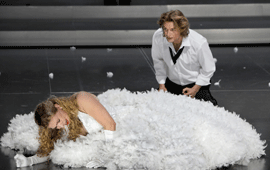> [Archived] Chronicles

Bayreuth Three - Lohengrin
I am sure you are wondering why rats in this Lohengrin version, directed by Hans Neuenfels! The artist, who made a name for himself in 1974 as a wide range opera director with a rich and diversified repertoire, from classic to modern, has managed to direct on the famous stage of the Bayreuth Festspielhaus in 2010, at seventy-one years old. After he terrifies you - it is a tough surprise, when the curtain lifts, after the seraphic Prelude - to discover on stage an... army of huge black rats! - his director's vision makes sense, the horror becomes amusement - especially when a family of rodents makes its appearance where the pink rat babies are intentionally moving in a silly manner - and then everything that is superfluous disappears and delight fully overcomes you. A true maestro, Hans Neuenfels uses obvious suggestions - the people, they are dominated by petty feelings, they are mean, prone to mistrust and aggression, changes they're mood from a moment to the next and... they are very attached to a group mentality. The exceptional costumes were imagined by Austrian Reinhard von der Thannen, who was several times named by the Opernwelt as 'costume creator of the year". It is true, in the moments then truth and justice are invoked, the rats remove their skins - but, even dressed in regular clothes they keep their obvious paws and claws under their skirts or trousers. Telramund and Ortrud, me and them, symbolically, black costumes predominantly, the moment when he rushes forward to kill Lohengrin in the back, Telramund himself turns into a rat. At the opposite pole, the sparkling, innocent white of Lohengrin and Elsa's costumes, their discreet and nuanced performance and, especially, Richard Wagner's splendid music.
I think it is time to say a few words about the only orchestra of the Bayreuth Festival. When opening the famous theatre, named Festspielhaus, in 1879, with the full performance of Der Ring des Nibelungen (The Ring of the Nibelung) tetralogy, Wagner carefully created his own orchestra. At the second edition of the festival, in 1882, for Parsifal, at the wish of king Ludwig II of Bavaria, the composer had at his disposal the orchestra and the choir of the theatre in Munich, which returned to Bayreuth for the 1883 and 1884 festivals. After one year break, the Festival takes place again and in 1885, in the pit, gathers some of the best German instrumentalists in the entire country. And thus the foundations of a wonderful tradition are placed. Every year the members of the orchestra are different - with the same core, obviously, but which is also in permanent improvement but which assures, in a way, its continuity. There are instrumentalists who have played in numerous editions of the festival; there are others who have come to Bayreuth only for the summer of 2012. Even if the financial rewards does not come up to the standards of other lyrical theatres in the world, the joy to perform here is not like any place in the world, to perform the Wagnerian scores in the maestro's home fills one with incomparable joy. At this 101 edition of the Festival in Bayreuth the orchestra was made up of exceptional instrumentalists, members of renowned ensembles from Berlin, Stuttgart, Köln, Hamburg, Munich, Dresden, Mannheim, Hanover, Leipzig, Vienna, Zurich, Budapest.
Translated by Florina Sămulescu
MTTLC, Bucharest University














